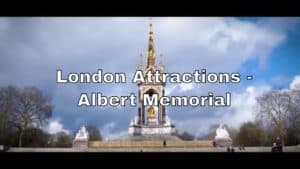Exploring the Beauty of County Londonderry
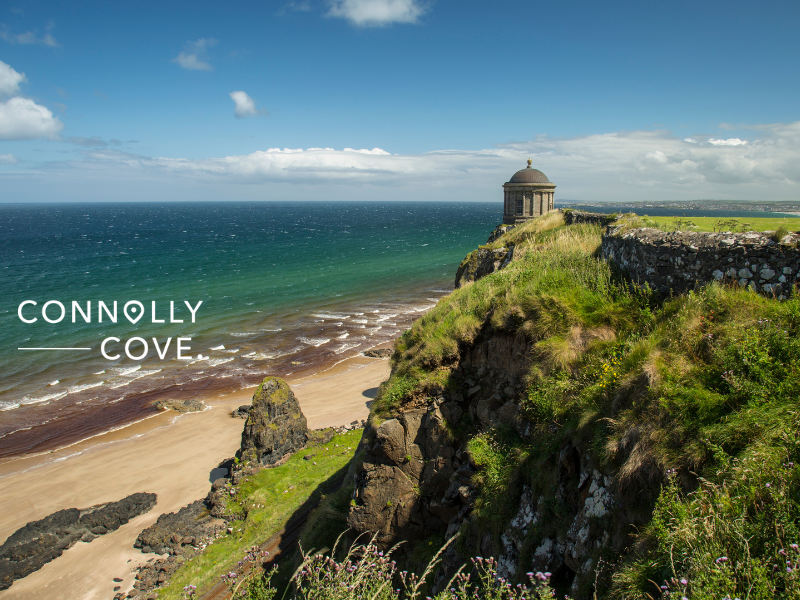
Updated On: December 17, 2023 by Noha Basiouny
Nestled in the heart of Northern Ireland, County Londonderry stands as a captivating blend of diverse landscapes, rich history, and vibrant culture. Steeped in tradition yet embracing modernity, this enchanting county offers a journey through time, from ancient sites echoing tales of middle ages fights to modern cities pulsating with life.
Known for its welcoming communities and warm hospitality, County Londonderry beckons travellers to uncover the hidden gems that lie within its picturesque countryside, historic landmarks, and lively urban centres.
In a previous story, we explored the enchanting history of County Londonderry since its establishment in the 17th century up until the late 20th century. In this article, we are going to embark on a journey to discover the wondrous nature of this county, the historic attractions that make it a timeless destination, and how to spend a well-deserved vacation there.
So, let’s hop into it.
Once Again, County Londonderry
County Londonderry is the second smallest of the six counties that make up Northern Ireland. Its establishment goes back to the early 17th century when the English monarchy sought to solidify its grip over Ireland by initiating the Plantation of Ulster, which mainly intended to introduce Protestantism at a large scale to the already Catholic country.
Such a movement required the establishment of a new city and the turning of the area around it into a county, which replaced what was formerly known as County Coleraine, located in the province of Ulster.
Derry
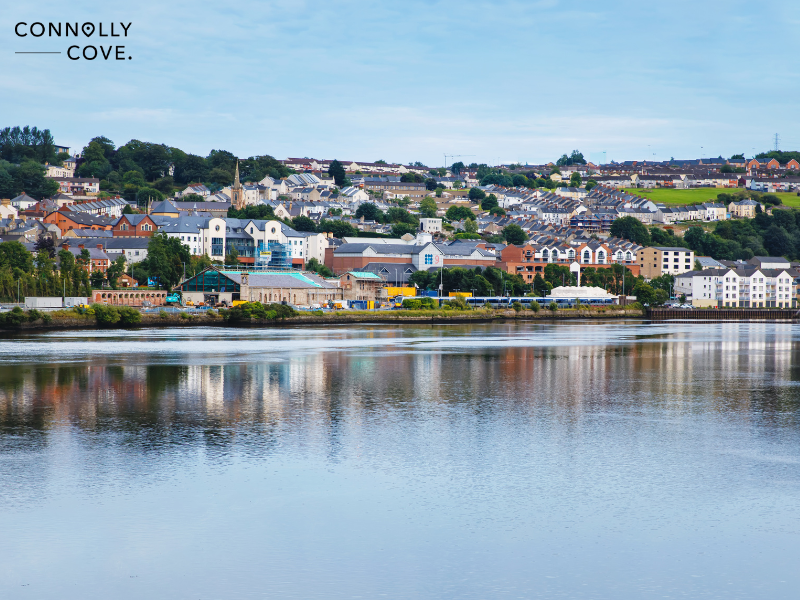
So Derry came into existence in 1613 and became County Londonderry’s administrative and primary urban centre and, by far, its largest city. It is best known for its powerful, well-preserved, 17th-century mediaeval walls that withstood the harsh Siege of Derry in 1689—you can learn more about this from our previous historical journey in the county.
The old city of Derry is located on the west bank of the River Foyle. Over the years, it was developed and expanded to include more areas on the east bank of the river, making a total area of 387 square kilometres.
The name of the city, however, has been subject to controversy over the past five centuries and can pretty much identify someone’s political approach.
Legally, the city and the county are both called Londonderry, where one can understand which one is meant only from the context. Historically, however, the Catholic population has always referred to the city as “Londonderry,” while the Protestants preferred the name “Derry.”
If you remember well, a charter was granted by King James I in 1613 to establish the city of Derry and enclose it by a county. The Irish name Doire, meaning oak grove, was originally given to the city, for the oak tree has been strongly associated with Irish culture as the country is native to two types of it. Doire became Derry in English.
The addition of London before Derry was to confirm the connection with England, which mainly constructed the city as part of a huge colonisation plan to spread Protestantism.
Yet, over the centuries, there have always been divisions and tensions between the Catholic and Protestant communities in the city, which intensified during the Troubles (1960s – 1990s). The Nationalists, representing the Catholic majority, call the city Derry to reflect their Irish heritage and desire for self-determination. On the other hand, the Unionist party, which represents the Protestants, refer to the city as Londonderry.
That being said, the local government district, something like the city council, that was created by merging the city of Derry and the district of Strabane District in 2015, is officially called Derry City and Strabane District Council.
So yes, the name Derry seems to be receiving more votes than just Londonderry, which is better kept for the county itself.
Weather
Like much of the United Kingdom and Ireland, the climate in County Londonderry is characterised by mild temperatures, influenced by the proximity to the Atlantic Ocean. It receives a significant amount of rainfall all year long. Rain is evenly distributed across the seasons, and drizzle is not uncommon. The prevailing westerly winds can bring moist air from the Atlantic, contributing to the region’s precipitation.
Winter lasts from December to February and features temperatures spanning between 7°C and 10 °C, rarely falling below freezing with the possibility of occasional cold spells. Frost and snow are possible, but they are usually not extreme.
Summer, on the other hand, starts in June and ends sometime in late August. It is generally cool, with average temperatures ranging from moderate to warm, somewhere between 16°C to 20°C. While infrequent heatwaves are possible, the Atlantic Ocean helps regulate temperatures, preventing extremes of heat.
Nature
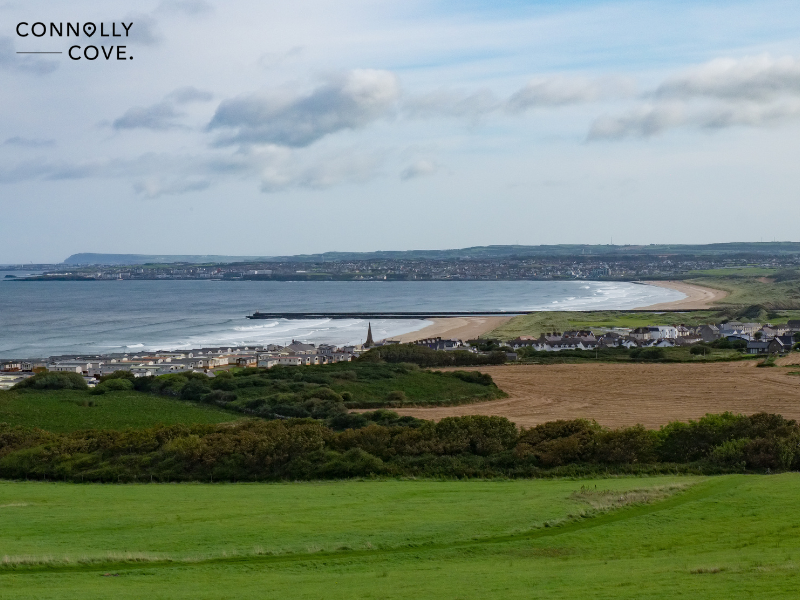
County Londonderry has a diverse geography and many fascinating places to explore. It boasts lush green valleys, stunning mountains, and breathtaking coastal scenery.
For example, the Sperrin Mountains, often referred to simply as the Sperrins, are a range of mountains that span across Counties Londonderry and Tyrone. They are the largest mountain range in Northern Ireland and are known for their scenic beauty, diverse landscapes, and rich biodiversity.
The Sperrins are considered a designated Area of Outstanding Natural Beauty (AONB) and offer a peaceful and unspoiled environment for outdoor enthusiasts, hikers, and nature lovers. The region is best known for its rolling hills, lush valleys, and distinctive landscapes, making it a popular destination for anyone seeking a retreat into nature.
Around 47 kilometres away from the Sperrins, the Binevenagh Mountain is located. It is characterised by its dramatic cliffs that rise sharply from the surrounding landscape, offering stunning panoramic views of the North Coast, the far Sperrin Mountains, and Lough Foyle. The mountain and its surroundings also offer opportunities for activities like hiking, walking, and birdwatching.
Benone Strand is one of County Londonderry and Northern Ireland’s most popular and longest beaches, stretching 11 kilometres along the Atlantic coastline. It is bordered by extensive sand dunes, providing not only an ideal destination for long walks, beachcombing, and various water and beach activities but it is also a habitat for unique plant and animal species. The dunes contribute to the overall beauty and biodiversity of the area.
County Londonderry is also home to several parks, such as the Limavady Country, the Roe Valley Country Park, and the Foyle Maritime Park, all of which feature woodlands, waterfalls, riverside walks, diverse flora and fauna, and picturesque landscapes. They also have trails for walking and cycling, providing a peaceful escape into nature.
Historical Attractions and Activities
Besides stunning nature, County Londonderry is rich in history and boasts several historical attractions that offer a fantastic array of experiences, from exploring medieval castles and historic houses to walking along ancient city walls and visiting sites with connections to Irish mythology.
The City Walls of Derry are by far the most popular and enchanting historical attraction in the county. Constructed between 1613 and 1618, these walls are among the best-preserved city walls in Europe and offer a fascinating glimpse into the city’s rich history. They stretch for approximately 1.5 kilometres and boast seven gates, each with its own unique history and significance.
Then there is the Guildhall. This is a striking neo-Gothic building located in the heart of Derry and dating back to 1890. Throughout these years, it has been a central hub for civic and cultural events. The interior of the building features beautiful stained glass windows and a large hall.
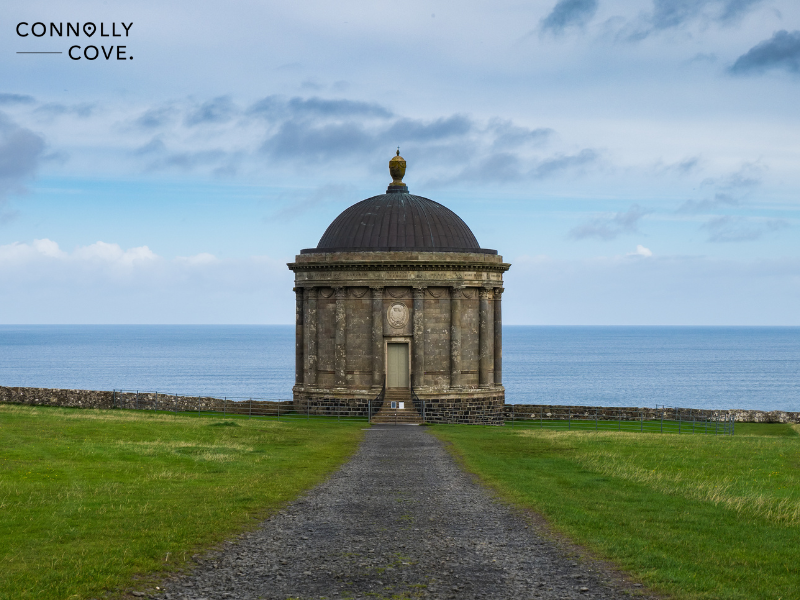
There is also the Mussenden Temple and Downhill Demesne located on the cliffs of Binevenagh Mountain. The Mussenden Temple is an 18th-century structure overlooking the Atlantic Ocean, and it is part of the Downhill Demesne. This is a National Trust property with gardens, woodlands, and the ruins of Downhill House—this is an 18th-century mansion belonging to the 4th Earl of Bristol and Lord Bishop of Derry.
Bellaghy Bawn is another fantastic attraction that tourists flock to when in the county. It is a well-preserved plantation-era fortified house located in the village of Bellaghy—about 61 kilometres from Derry. Bellaghy Bawn provides insight into the architecture and lifestyle of the time of the 17th century.
The Workhouse Museum in Derry provides a glimpse into the harsh living conditions faced by the poor and destitute during the 19th century. It is a restored Victorian workhouse with exhibits on the workhouse system, totally worth visiting. Located near Derry, Prehen House is another elegant 17th-century mansion with a history that spans several centuries. The house has a notable collection of art and antiques.
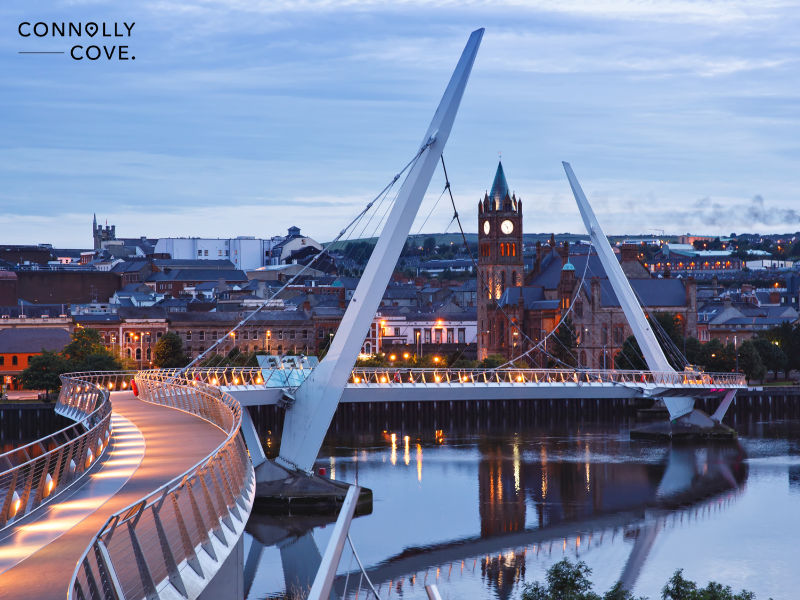
Though it is probably the most recently-built attraction, the Peace Bridge in Derry stands as a symbol of reconciliation and unity in the city that has historically been marked by divisions. It was officially inaugurated on 25 June, 2011 and spans the River Foyle, connecting the city centre to the Waterside area.
The bridge’s distinctive S-curve design, coupled with illuminated steel sculptures at each end, contributes to its iconic presence. Serving exclusively as a pedestrian and cycle bridge, it not only provides a vital physical link between communities but also embodies the aspirations for peace and understanding in Northern Ireland.
Traveller’s Guide to County Londonderry
Generally speaking, County Londonderry is a year-round destination, and each season offers its own unique charm. The tourist season there, as in much of Ireland and Northern Ireland, generally follows a pattern common to many temperate climates.
For instance, the peak tourist season typically occurs during the summer months, from June to August. This is when visitors can usually enjoy milder temperatures, longer daylight durations, and a more vibrant atmosphere. Many outdoor attractions, festivals, and events take place during summer.
The shoulder seasons, which include late spring (April to May) and early autumn (September to October), also attract tourists. During these months, the weather is still relatively mild, and attractions are less crowded compared to the peak summer season.
Winter, which begins in November and ends sometime around late February, constitutes the low tourist season, where the weather is cooler, and daylight hours are shorter. The winter months typically appeal to those who seek a quieter experience and are interested in indoor attractions and cultural events.
Getting There
Getting to County Londonderry depends on every visitor’s starting location and their preferred mode of transportation.
The most convenient way to get to County Londonderry is by air, where the City of Derry Airport is the primary airport serving the county. It offers domestic flights within the UK but limited international ones. If flying from outside Northern Ireland, visitors may consider arriving at Belfast International Airport. From there, they can take a bus or train or rent a car to reach County Londonderry.
Visitors can also take the train or a bus from anywhere in Northern Ireland to County Londonderry, where they can best enjoy scenic views of the Northern Irish countryside. Translink is a rail and bus service operator that offers various trips to and from the county on a daily basis.
County Londonderry is also accessible by road. Visitors can rent cars and drive to the county through major routes, including the A2 and A6. Driving allows more flexibility to explore the county’s rural areas and attractions.
That being said, it is advisable that visitors check transportation schedules, routes, and any travel restrictions or guidelines that may be in place before they start their journey. They also need to consider the specific location within County Londonderry they wish to visit, as transportation options may vary.
Getting Around
Getting around County Londonderry involves a variety of transportation options, depending on personal preferences and the locations visitors wish to visit.
Renting a car is a convenient way to explore County Londonderry, especially if visitors want to visit rural areas or places not easily accessible by public transportation. Major towns like Derry and Coleraine have car rental services.
Public transportation includes bus services, such as the Ulsterbus and Goldline, which connect towns and cities within the county and beyond. The Northern Ireland Railways network connects some parts of County Londonderry, with Coleraine being a major rail hub. Taxis are also available in towns and cities to get from here to there in the county. They are quite convenient for short trips within towns.
If not into transportation that much, visitors can either cycle or walk. If they do not prefer that either, visitors can spare themselves the hassle of planning by joining guided tours or day trips organised by local tour operators to explore specific attractions or regions.
Accommodation
County Londonderry offers a range of accommodation options that suit every traveller’s preference and budget. The availability of accommodations, however, may vary based on the time they are visiting the county, so visitors should invest in some profound research before heading there.
Now, here are some types of accommodations they can consider:
- Hotels: There are hotels of various sizes and styles in Derry and other towns throughout the county. These range from boutique hotels to larger chain options.
- Bed and Breakfasts (B&Bs): B&Bs are quite a popular choice for travellers looking for a more intimate and personalised experience. They are often located in residential areas or the countryside.
- Guesthouses: Similar to B&Bs, guesthouses provide a comfortable and often more homely atmosphere. They can be found in both urban and rural settings.
- Self-Catering Accommodations: Visitors seeking more independence can rent a self-catering cottage, apartment, or holiday home. This option allows them to have their own space and facilities for cooking.
- Country Inns: Some charming country inns and pubs offer accommodation along with traditional Irish hospitality. These can be found in rural areas or small villages.
- Caravans, Holiday Parks, and Campsites: For those who enjoy camping or caravanning, there are holiday parks and campsites available in County Londonderry. These options provide a closer connection to nature.
- Luxury Accommodations: If visitors are looking for a more luxurious stay, there are upscale hotels and boutique accommodations that offer premium amenities and services.
Again, when searching for accommodation, it is recommended that visitors consider factors such as location, budget, and the type of experience they are seeking. Booking websites, travel agencies, and tourism information centres can provide information and assistance in finding the accommodation that best suits their preferences.
County Londonderry is more than a destination; it is an invitation to embark on a journey through time, culture, and natural wonders. Whether you have walked the city walls, stood atop Binevenagh Mountain, or strolled along the sandy shores of Benone Strand, County Londonderry’s allure lies in its ability to surprise and please at every turn.
As we bid farewell to this remarkable county, let the echoes of its stories linger in your memories, a testament to the enduring spirit of a place where history and beauty intertwine, inviting all who visit to become part of its narrative. Until the next adventure, may the spirit of County Londonderry stay with you, a cherished chapter in the story of your travels.





